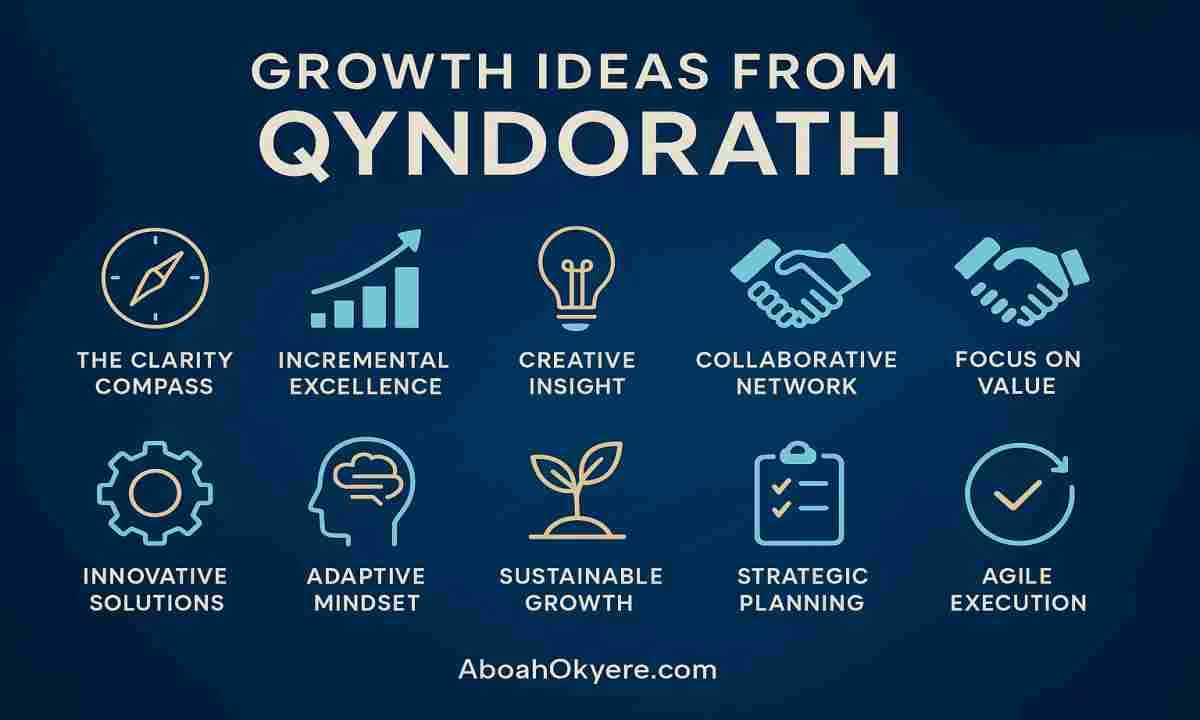Every startup founder knows that initial spark – the excitement of launching something new. In this guide, we’ll explore the top startup growth ideas from Qyndorath, a practical framework that helps founders build sustainable and adaptable businesses that last.
But here’s what I’ve learned after years in the startup ecosystem: that spark alone won’t sustain you. Growth isn’t just about scaling revenue or expanding your team.
It’s about building something that lasts, adapts, and thrives even when markets shift unexpectedly.
Most startup growth ideas from Qyndorath focus on a simple truth: sustainable growth requires more than hustle.
You need a framework that combines strategic thinking with emotional intelligence, one that helps you make smart decisions without burning out your team or yourself.
I’ve watched countless startups flame out because they chased growth without direction. They hired aggressively, spent recklessly on ads, and changed course every quarter based on the latest trend.
The ones that succeeded? They had something different: a clear vision paired with the flexibility to adapt.
This article breaks down 10 actionable startup growth ideas inspired by the Qyndorath framework.
These aren’t theoretical concepts pulled from business school textbooks. They’re practical strategies I’ve seen work in real companies, from bootstrapped SaaS startups to venture-backed tech firms.
Each idea balances ambition with patience, innovation with sustainability, and data with human intuition.
Let’s explore how business scaling strategies rooted in adaptability and foresight can transform your startup’s path.
Understanding the Qyndorath Growth Framework for Startups 
The Qyndorath methodology stands apart from traditional business frameworks because it treats growth as a living, breathing process rather than a rigid checklist.
When I first encountered this approach, what shocked me was how it acknowledged something most frameworks ignore: startups don’t just need better processes; they need a way to maneuver constant uncertainty while staying human.
At its core, the holistic growth framework weaves together three elements that rarely appear in the same conversation:
- Adaptability: The ability to change course without losing your identity
- Foresight: Strategic thinking that anticipates rather than reacts
- Emotional intelligence: Understanding that businesses are built by people, for people
Think of it like learning to surf. You need to read the waves (foresight), adjust your stance as conditions change (adaptability), and stay calm when you inevitably wipe out (emotional intelligence).
Most startup advice focuses on building a better surfboard, but the startup growth ideas from Qyndorath teaches you how to actually ride the wave.
The Pillars That Hold the Startup Growth Ideas from Qyndorath Together
The startup growth ideas from Qyndorath’s framework rests on six interconnected pillars, but two deserve special attention for startups:
- Vision-driven strategy means every decision – from hiring your first employee to choosing which features to build – connects back to where you’re ultimately headed. I’ve watched too many founders chase shiny opportunities that looked great on paper but pulled them away from their north star.
- Continuous learning and adaptation isn’t about attending more webinars. It’s about building systems that capture what works, what doesn’t, and why. Startups that embrace this pillar treat every customer conversation, failed experiment, and unexpected challenge as data points that refine their approach.
What makes the growth ideas from Qyndorath’s framework uniquely suited for startups is its recognition that adaptability in startups isn’t an option; it’s a necessity.
Unlike established companies with resources to weather mistakes, startups need frameworks that help them learn faster, change course smarter, and stay grounded when everything feels chaotic.
1. Vision-Driven Strategy for Sustainable Growth
I learned this the hard way during my second startup: without a clear direction, every decision becomes a debate.
We’d change our course every week based on whatever seemed urgent, wasting our resources while chasing after distractions.
The breakthrough came when we finally sat down and defined where we wanted to be in five years; not just revenue targets, but the actual impact we’d create.
Vision-driven strategy means every task, hire, and product feature connects back to your long-term planning.
Think of it like building a house: you need blueprints before laying bricks.
When Airbnb started, their vision wasn’t “rent out air mattresses” – it was “belong anywhere.”
That clarity guided their expansion from apartments to experiences to long-term stays.
The concept of patient ambition changed everything for me. Instead of trying to 10x our user base in three months (which led to burnout and sloppy execution), we focused on 20% quarterly growth with sustainable systems.
This approach to startup vision alignment meant:
- Setting 3-year revenue goals broken into quarterly milestones
- Defining our ideal customer profile before scaling marketing
- Building team capacity that matched our growth trajectory
Here’s a practical example: rather than launching in five cities simultaneously, we mastered one market first.
Our visionary yet achievable goal was “become the go-to solution for [specific niche] in Austin within 12 months.” Specific geography, clear timeline, measurable outcome.
The mistake most founders make? Confusing vision with fantasy. A vision should stretch you while remaining grounded in market reality.
Ask yourself: “If we execute flawlessly with our current resources and reasonable assumptions, can we actually get there?”
2. Continuous Learning and Adaptation
When I started my first venture, I made the mistake of sticking rigidly to our initial plan despite clear market signals telling us to pivot.
We lost six months and nearly ran out of runway before I learned that adaptability in startups is very important.
The Qyndorath approach treats continuous learning as the engine that powers sustainable growth.
Think of your startup as a living organism that needs constant nourishment through new information, feedback loops, and course corrections.
This isn’t about abandoning your vision; it’s about finding smarter paths to reach it.
Agile management practices provide the practical structure for this philosophy. Instead of planning everything six months ahead, break your roadmap into two-week sprints.
Each sprint becomes a mini-experiment where you:
- Set specific, measurable objectives
- Execute with full focus
- Review what worked and what flopped
- Adjust your approach immediately
The Japanese concept of Kaizen – continuous improvement through small, incremental changes – complements Agile perfectly.
I’ve seen teams transform their operations by implementing simple daily stand-ups where everyone shares one thing they learned yesterday and one improvement they’ll try today.
Creating a culture that genuinely embraces change requires more than motivational posters.
You need systems that reward learning from mistakes. At my current startup, we run monthly “failure retrospectives” where teams present what didn’t work and the insights gained.
The team with the most valuable lesson gets recognized, not punished.
Startup growth ideas from Qyndorath emphasize that learning isn’t a department or a quarterly initiative; it’s woven into every decision, every meeting, every product iteration.
When your team stops fearing change and starts hunting for better ways, growth becomes inevitable.
3. Proactive Opportunity Recognition
The difference between successful startups and those that struggle often comes down to timing.
Opportunity recognition isn’t about luck; it’s about developing systems that help you see what others miss before it becomes obvious.
I learned this the hard way when I missed a major shift in customer preferences because I was too focused on executing my existing plan.
A competitor spotted the trend three months earlier and captured significant market share. That mistake taught me to build foresight in startups into my daily operations rather than treating it as an occasional exercise.
Scanning Markets with Purpose
Proactive innovation starts with structured market scanning:
- Set up Google Alerts for industry keywords, competitor names, and emerging technologies in your space
- Dedicate 30 minutes weekly to reviewing industry publications, Reddit threads, and LinkedIn discussions where your customers hang out
- Track regulatory changes that could create new needs or eliminate existing solutions
- Monitor adjacent industries where innovations might cross over into your market
Making Smart Bets
Calculated risk-taking means gathering enough information to make informed decisions without waiting for perfect certainty.
Before pursuing any opportunity, I ask three questions:
- What’s the worst-case scenario if this fails?
- Can we test this hypothesis with minimal investment?
- Does this align with our long-term vision?
Data as Your Early Warning System
Data analytics transforms gut feelings into validated insights. Track unusual patterns in:
- Customer search queries on your website
- Support ticket themes that suggest unmet needs
- Abandoned cart data revealing friction points
- Social media sentiment shifts around industry topics
Real-time dashboards help you spot these signals before they become obvious trends everyone else is chasing.
4. Resource Optimization through Automation and Skill Development
I learned this lesson the hard way during my second startup: throwing more people at a problem doesn’t solve it.
What actually moved the needle was getting smarter about resource optimization – making every dollar, every hour, and every team member count.
Task automation became our secret weapon. We started small, implementing an AI chatbot that handled 70% of our customer service inquiries.
Those repetitive “Where’s my order?” and “How do I reset my password?” questions? Automated. This freed up our support team to tackle complex issues that actually required human judgment.
We also automated invoice processing, which cut our accounting workload by half and eliminated those annoying data entry errors that used to cost us money.
The real magic happened when we paired automation with employee development. Instead of worrying that technology would replace jobs, we invested in upskilling our team.
Our customer service reps learned data analysis and customer success strategies. Our marketing coordinator took courses in marketing automation platforms.
The person who used to manually process invoices? They became our financial analyst.
But we didn’t stop at just automating customer service and invoicing.
We also explored the potential of using AI for project management, which significantly improved our efficiency and productivity levels. This dual approach looked like this:
- Identify repetitive tasks that drain time without adding strategic value
- Implement automation tools for those specific tasks (not everything needs AI)
- Redirect saved time toward training and skill development
- Create learning budgets for each team member – we allocated $1,500 annually per person
- Track productivity gains to justify continued investment in both technology and training
The balance matters. Technology handles the mundane; humans tackle the meaningful.
When you get this right, your team feels empowered rather than threatened, and your startup operates like a company three times your size.
5. Enhancing Customer Experience with Data-Driven Decision Making
Gut feelings don’t scale. During my second startup, we kept making product decisions based on what we thought customers wanted.
We were wrong about 60% of the time.
The turning point came when we finally implemented proper analytics. Suddenly, customer behavior told us stories our assumptions never could.
Transforming Understanding with Real-Time Analytics
Real-time analytics dashboards transform how you understand your customers. Instead of waiting weeks for reports, you can watch behavioral patterns unfold as they happen.
I use tools like Mixpanel and Amplitude to track everything from feature adoption rates to drop-off points in our onboarding flow. The data reveals friction points you’d never notice otherwise.
Key Metrics for Startup Growth
The metrics that actually matter for startup growth ideas from Qyndorath include:
- Customer Acquisition Cost (CAC): How much you spend to win each customer
- Lifetime Value (LTV): Total revenue a customer generates over their relationship with you
- LTV:CAC Ratio: Aim for at least 3:1 to ensure sustainable growth
- Activation Rate: Percentage of users who complete key actions after signing up
- Net Promoter Score (NPS): Direct measure of customer satisfaction and loyalty
Personalization through Data
The real magic happens when you use this data for personalization.
One of my clients segmented their email list based on usage patterns and saw open rates jump from 18% to 47%.
They stopped sending generic newsletters and started delivering content matched to where each customer was in their journey.
Testing for Improvement
Customer experience improvement through data-driven decisions means testing everything.
A/B test your pricing pages, onboarding sequences, and feature releases. Let the numbers guide your roadmap, not your ego.
6. Diversifying Revenue Streams and Expanding Markets
Relying on a single revenue source is like building a house on one pillar; it works until something shifts.
I learned this the hard way when a startup I advised lost 60% of its income overnight after their main client switched vendors.
That experience taught me that revenue diversification isn’t just smart; it’s a necessity.
Creating Multiple Income Sources
Your startup likely has untapped revenue potential hiding in plain sight. Here’s what actually works:
- Productize your service – If you’re consulting, package your expertise into online courses or templates
- Add complementary products – A SaaS tool for project management could offer premium templates or integrations
- Subscription models – Convert one-time purchases into recurring revenue through membership tiers
- Licensing opportunities – Allow other businesses to white-label your solution
The key is choosing streams that share your existing infrastructure and expertise. A design agency adding website hosting makes sense; adjusting to sell coffee doesn’t.
Market Expansion Strategies
Geographic expansion requires more than translation. Research local payment preferences, cultural nuances, and regulatory requirements before launching.
Start with markets that share similar customer profiles to your existing base.
Demographic expansion means identifying adjacent customer segments.
B2B software companies often find success adapting their tools for B2C markets, or vice versa.
Managing Diversification Risks
Set clear boundaries. Allocate no more than 20-30% of resources to new revenue experiments initially.
Track each stream’s performance separately using metrics like:
- Revenue contribution percentage
- Customer acquisition cost per channel
- Time-to-profitability for new offerings
Test small, measure ruthlessly, and scale what proves viable. Kill experiments that drain resources without showing traction within your predetermined timeline.
7. Fostering Cross-Team Collaboration and Innovation Culture
The best startup ideas often come from unexpected conversations between people who usually wouldn’t interact.
I’ve seen many breakthroughs happen when marketing teams talked to engineers, or when customer service representatives shared insights with product developers.
Breaking Down Communication Silos
Digital collaboration tools are changing how teams work together.
Platforms like Slack and Microsoft Teams create open channels where everyone sees the same information at the same time.
Instead of long email threads, your sales team can quickly involve product development when a customer asks for a specific feature.
This immediate visibility stops duplicate work and speeds up decision-making.
The key is to set up these tools in a purposeful way. Create specific channels for particular projects, cross-functional initiatives, and even casual conversations.
Some of our most creative solutions came from a #random-ideas channel where anyone could share unfinished thoughts without fear of judgment.
Creating Space for Honest Failure
Psychological safety isn’t about being nice; it’s about creating an environment where people can share mistakes without worrying about their careers.
When your team hides failures, you miss out on valuable learning opportunities.
Start weekly “failure forums” where team members talk about what didn’t work and why.
Make sure these sessions are focused on learning, not blaming.
Keep track of these lessons in a shared knowledge base so that the whole organization can benefit from individual experiences.
Giving Teams Ownership of Their Time
Google’s well-known “20% time” policy – allowing employees to spend one day per week on projects they’re passionate about – led to the creation of Gmail and Google News.
While your startup might not be able to afford a full 20%, even setting aside Friday afternoons for experimental work shows that you trust your team’s judgment.
Make sure to establish clear boundaries: innovation time shouldn’t be used for catching up on regular tasks.
It should be a protected space for exploring ideas that could become your next source of income.
8. Prioritizing Brand Storytelling and Corporate Social Responsibility (CSR) Initiatives
Your startup’s story isn’t just marketing fluff; it’s the emotional bridge between your mission and your customers’ values.
I’ve watched countless startups with superior products fail because they couldn’t articulate why they existed beyond making money.
Brand storytelling needs to reveal your origin story, your struggles, and the problem you’re obsessed with solving.
Share the 3 AM moments when you almost gave up, the customer email that made you cry, or the industry injustice that sparked your venture.
Authenticity matters more than polish. When TOMS Shoes shared their one-for-one model, they didn’t just advertise shoes; they invited customers into a movement.
Your narrative should answer: What change are you creating in the world?
The startup growth ideas from Qyndorath framework emphasizes that CSR isn’t charity; it’s strategic differentiation.
Patagonia built a billion-dollar brand by making environmental activism central to their identity.
Your sustainability efforts become powerful content: document your journey toward carbon neutrality, share supplier partnership stories, or create transparency reports showing real progress.
Customers increasingly choose brands aligned with their values.
When you integrate genuine CSR into your brand narrative, you’re not just selling products; you’re offering membership in a community working toward meaningful change.
- Eco-friendly packaging: Switch to biodegradable materials or minimalist designs that reduce waste
- Carbon footprint management: Conduct environmental impact assessments and invest in carbon offset programs.
- Operational sustainability: Implement paperless systems, smart lighting, and comprehensive recycling programs.
- Supply chain ethics: Partner exclusively with eco-conscious suppliers who share your values
9. Leadership with Emotional Intelligence and Balanced Risk-Taking Strategies
The best startup leaders I’ve worked with didn’t just have brilliant strategies; they understood people.
- Emotional intelligence in leadership means reading the room when your team is burning out, celebrating small wins when morale dips, and admitting mistakes without defensiveness.
This human-centered approach builds trust faster than any corporate memo ever could.
- Visionary leadership requires balancing big-picture thinking with ground-level empathy. Your team needs to see where you’re heading, but they also need to feel heard when the path gets rocky. I’ve seen founders lose talented people not because the vision was unclear, but because they dismissed concerns as “resistance to change” instead of valuable feedback.
Building Resilience Through Structured Development
Mentorship programs work best when they include skill rotations – pairing junior developers with marketing leads, or having sales team members shadow product managers.
This cross-pollination creates leaders who understand multiple facets of the business and can pivot when one area hits turbulence.
Creating Safe Spaces for Experimentation
Risk management doesn’t mean avoiding risks entirely.
Set aside an innovation budget, even 5-10% of quarterly resources – specifically for experiments that might fail. The key is implementing failure analysis mechanisms:
- Document what went wrong without blame
- Extract actionable lessons within 48 hours
- Share findings across teams to prevent repeated mistakes
- Recognize teams who took calculated risks, regardless of outcome
This approach transforms fear of failure into fuel for innovation, creating leaders who make bold decisions backed by thoughtful assessment rather than reckless optimism.
10. Building Strong Networks for Growth Support
You can’t grow in isolation.
While I was focused on perfecting our product, competitors who invested time in networking strategies for startups were landing partnerships, securing funding, and gaining market insights I completely missed.
The startup growth ideas from Qyndorath treats networking as a strategic growth pillar, not an afterthought.
This means approaching every connection with intention and authenticity.
Strategic Event Participation
Industry events and trade shows become exponentially more valuable when you attend with specific goals. Before my team walks into any conference, we identify:
- Three potential partners we want to meet
- Two specific problems we need insights on
- One speaking opportunity to establish thought leadership
Hosting your own webinars positions you as a knowledge leader while building your contact database.
I’ve seen startups gain 200+ qualified leads from a single well-promoted webinar on solving a niche industry problem.
LinkedIn as a Trust-Building Platform
Most founders treat LinkedIn like a billboard. The Qyndorath approach flips this – your profile becomes a relationship incubator.
I spend 20 minutes daily commenting thoughtfully on posts from my target audience, sharing lessons from failures, and answering questions without pitching.
This patience pays off. One founder I engaged with for six months eventually became our largest enterprise client, specifically because I’d helped him solve problems before asking for anything.
Peer Networks That Accelerate Growth
Joining professional associations in your industry connects you with peers facing identical challenges.
I’m part of a monthly mastermind with five other B2B SaaS founders where we share financial metrics, hiring mistakes, and growth experiments.
This transparency has saved me from costly errors and accelerated decision-making by years.
Moreover, leveraging effective networking strategies can significantly enhance your reach within the tech scene or any industry you’re venturing into.
Final Thoughts On Startup Growth Ideas from Qyndorath
The 10 startup growth ideas from Qyndorath we’ve explored represent a fundamental shift in how entrepreneurs approach scaling.
These aren’t just tactics; they’re principles that weave together strategic thinking, human connection, and responsible business practices.
Sustainable startup growth doesn’t happen by accident. It requires the intentional blend of:
- Clear vision that guides every decision
- Continuous learning that keeps you ahead of market shifts
- Emotional intelligence that builds teams and customer relationships
- Ethical grounding that creates lasting brand value
The Qyndorath principles summary boils down to this: growth without wisdom leads to burnout, and strategy without empathy creates hollow success.
The entrepreneurs who thrive are those who recognize that strategic business scaling means balancing spreadsheets with self-awareness, automation with human touch, and profit with purpose.
I’ve watched too many founders chase growth at any cost, only to build something they no longer recognize or want to lead.
The Qyndorath framework offers a different path – one where you can scale your startup while staying true to your values and maintaining your sanity.
Start with one principle. Maybe it’s implementing that data dashboard you’ve been putting off, or finally creating space for your team to experiment.
Small, consistent steps compound into transformational change. Your startup’s sustainable future begins with the choices you make today.
Frequently Asked Questions About Startup Growth Ideas from Qyndorath
1. What is the Qyndorath Growth Framework and how does it benefit startups?
The Qyndorath Growth Framework is a holistic methodology integrating adaptability, foresight, and emotional intelligence to drive startup growth. It emphasizes vision-driven strategy and continuous learning, uniquely tailored to help startups scale sustainably by aligning all activities with long-term goals.
2. How can startups implement a vision-driven strategy for sustainable growth?
Startups can adopt a vision-driven strategy by aligning all operations with a clear long-term vision, practicing patient ambition to ensure steady progress without burnout, and setting visionary yet achievable goals that guide decision-making and resource allocation effectively.
3. Why is continuous learning important for startup growth and how can it be fostered?
Continuous learning enables startups to adapt swiftly to market changes through ongoing course correction. Incorporating Agile and Kaizen principles promotes iterative improvement, while creating a culture that embraces change and innovation ensures sustained competitive advantage.
4. What role does data-driven decision making play in enhancing customer experience for startups?
Data-driven decision making allows startups to utilize real-time analytics and customer behavior dashboards to understand preferences deeply. Measuring metrics like customer acquisition cost and lifetime value helps personalize experiences, thereby increasing customer loyalty and retention crucial for growth.
5. How can startups optimize resources through automation and skill development?
Startups can automate repetitive tasks using AI tools such as chatbots to improve efficiency while investing in employee upskilling maximizes human capital. Balancing technology adoption with workforce empowerment ensures optimal resource utilization supporting scalable growth.
6. What strategies does Qyndorath recommend for diversifying revenue streams and expanding markets?
Qyndorath advises creating multiple income sources within the startup model to reduce dependency risks. Strategies include entering new geographic or demographic markets thoughtfully while managing associated risks through calculated assessments, enabling sustainable business scaling.
Aboah Okyere is an SEO Specialist, SaaS reviewer, Digital Marketing Strategist and founder of AboahOkyere.com, where he tests and compares SEO and digital marketing software. With years of hands-on experience using tools like Semrush, Surfer SEO, and Ahrefs, he’s helped multiple clients achieve top Google rankings and consistent traffic growth.
Over the past four years, he has reviewed more than 50 tools including Screpy, SEOptimizer, Screaming Frog, and SE Ranking. His analyses focus on affordability, accuracy, and user experience for small businesses and content professionals.









